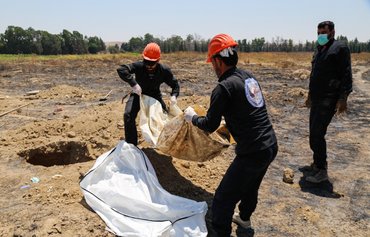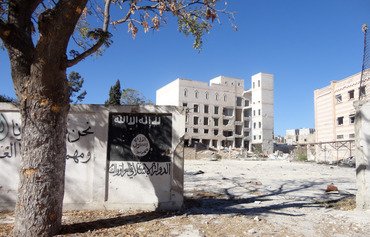An exhumation effort is under way in the Aleppo province city of Manbij, in northern Syria, after municipal workers unearthed in July a new mass grave of civilians killed by the "Islamic State of Iraq and Syria" (ISIS).
The gravesite was found just metres away from the Manbij Hotel, which the extremist group had co-opted as an interrogation centre when it occupied the area, between 2014 and 2016.
The remains were found handcuffed and blindfolded, and included the bodies of women and children, eyewitnesses told Al-Mashareq.
Municipal workers doing excavation work to upgrade the sewage system discovered the mass grave on July 27, a few metres away from the Manbij Hotel, said Ghassan Ibrahim, a unit commander with the Manbij Military Council.
![A photo taken September 25, 2016, shows the ISIS flag painted on the wall outside the Manbij hotel in Manbij, which ISIS used as a prison. A mass grave containing the remains of the group's civilian victims has been found near the site. [Ayham al-Mohammad/AFP]](/cnmi_di/images/2022/08/09/36606-manbij-hotel-syria-600_384.jpg)
A photo taken September 25, 2016, shows the ISIS flag painted on the wall outside the Manbij hotel in Manbij, which ISIS used as a prison. A mass grave containing the remains of the group's civilian victims has been found near the site. [Ayham al-Mohammad/AFP]
![Municipal workers in Manbij, seen here in a screenshot from a video posted on July 27, exhume the bodies of ISIS victims from a mass grave they discovered while doing excavation work to upgrade the sewage system. [Manbij TV Facebook page]](/cnmi_di/images/2022/08/09/36607-manbij-mass-grave-600_384.jpg)
Municipal workers in Manbij, seen here in a screenshot from a video posted on July 27, exhume the bodies of ISIS victims from a mass grave they discovered while doing excavation work to upgrade the sewage system. [Manbij TV Facebook page]
![Members of the Kurdish Red Crescent and the Manbij health committee catalogue the remains of ISIS victims found in a mass grave in the city, along with their personal belongings, in a screenshot from a video posted online on July 27. [Manbij TV Facebook page]](/cnmi_di/images/2022/08/09/36608-manbij-grave-exhumation-600_384.jpg)
Members of the Kurdish Red Crescent and the Manbij health committee catalogue the remains of ISIS victims found in a mass grave in the city, along with their personal belongings, in a screenshot from a video posted online on July 27. [Manbij TV Facebook page]
The municipality immediately contacted health committee members and Kurdish Red Crescent officials, he told Al-Mashareq, and an exhumation was organised.
Ibrahim said the gravesite is in an area formerly "known as the Security Square, which was closed to civilians because it contained a major investigation and interrogation centre set up by the group in the Manbij Hotel".
The discovery is unusual, he said, as ISIS "typically liquidated civilians and its opponents in areas that were relatively far from its centres".
Based on evidence unearthed so far, he said -- including the remains of children, women and men with their identification papers, photos and other belongings -- the victims had probably attempted to escape from areas under ISIS control.
It appears they were "hastily arrested and liquidated during the last days of the group's control of Manbij, which was liberated in 2016", he said.
Hotel of horrors
The five-storey Manbij Hotel once hosted foreigners and Syrians who would come to stay on weekend getaways, AFP reported.
But during its two-year reign, ISIS transformed the hotel into a nightmarish prison for anyone who violated the group's hardline interpretation of Sharia.
Ahmad Othman spent three months there in late 2015 after being accused of collaborating with anti-ISIS fighters, strung up by a chain and tortured.
"Our feet never touched the ground," he recalled in an October 2016 interview with AFP. "Sometimes they pulled the chain up and down" to make the pain worse.
"For a while after we were released, we could not walk or focus on anything anymore," he said.
The hotel's lower floors were transformed into an underground maze of dark cells and torture chambers, where the jailers watched their prisoners through crudely cut-out slats in the black metal doors.
Shower stalls were turned into solitary confinement cells, and in one room "prisoners would sit for days until they confessed" inside metal containers, Othman said.
Detainees were allowed only brief intervals during which they could choose to eat or pray -- and those who opted to have breakfast instead of completing their morning prayers were beaten, he said.
"They used to hit us everywhere, on our heads, our bodies.... They made us climb inside a large wheel that they would then hit," he said.
While Othman got out alive, others imprisoned with him were executed by ISIS.
"They just invent whatever accusation they feel like and behead people," Othman said. "How do they dare call themselves an Islamic state?"
Families await answers
The mass grave issue "is being dealt with as an absolute top priority, given the social dimension and the need of thousands of families to learn the fate of their sons and family members", said Kurdish Red Crescent official Azad Dudeki.
"The approximate number of the missing totals 8,000, including men, women and children who disappeared under mysterious circumstances or were arrested by the group’s elements," he told Al-Mashareq.
"All news of them ceased completely.”
"The search process is very difficult because of the lack of accurate information about the location of the graves, and many of them have been discovered already, from information provided by residents," Dudeki said.
So far, the remains of 30 individuals -- including women and children -- have been exhumed from the mass grave, Hussein Khalil, a member of the internal security forces in Manbij, told Al-Mashareq.
During the exhumation process, Khalil said, he noticed that all the bodies "were handcuffed behind their backs, and many were blindfolded".
Gunshot wounds were visible in some of the victims' skulls, he said.
Personal photos, documents
"Most of the remains included personal photos and documents belonging to the victims, which is a rarity," Khalil said.
"At mass graves discovered in the past, the exhumation teams did not find documents, which made it difficult to identify the victims and made DNA tests necessary," he noted.
"These are not available in northern Syria, and require time and funding, which hindered the identification of the victims," he said.
In contrast, he said, the names of the Manbij victims "will be announced after the remains, documents and photos that were found are examined and documented".
This massacre "may have occurred in the last days before the liberation of the city of Manbij, and the group's elements were liquidating all detainees in preparation for escaping from the area", said Khalil.
It is likely these executions took place hastily, for fear that the prisoners would identify the ISIS elements, after they became certain that the Syrian Democratic Forces (SDF) and international coalition had liberated the area, he said.

![Photos found in the Manbij mass grave, seen here in a screenshot from a video posted online on July 27, likely belonged to the victims. [Manbij al-Hadath Channel/Telegram]](/cnmi_di/images/2022/08/09/36605-manbij-grave-photos-600_384.jpg)






